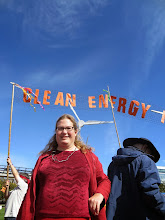Let me start by saying that XCEL Energy employs some very fine people who take their duties very seriously and believe in the company's motto "Responsible by Nature." They have worked very hard for renewables integration, Community Solar Gardens in particular. That's why the company's actions of the past week have been disappointing, but not entirely unexpected.
From my "Save the San Luis Valley" blog on June 14, 2010:
San Luis Valley Transmission Line Could Cost Colorado 25,000 Solar jobs over ten years
In this article. 25,000 job-years over ten years corresponds almost exactly with the 2,000-3,000 jobs at risk today from XCEL's recent rebate cuts:
The cuts came only four days days after the transmission line's approval by the Colorado Public Utilities Commission:
The proposed San Luis Valley - Calumet - Comanche transmission line would run directly from Colorado's newest coal-fired power station into the San Luis Valley. With no requirement to carry renewable energy, the line would often be bringing in carbon intensive energy.
Both the transmission line and the massive solar development it would lead to would provide XCEL guaranteed profits by increasing everyone's electric bill - a strategy it explicitly adopted in 2003 called "Building the Core":
Solar on rooftops, owned by the people who use it, reduces the amount of electricity XCEL sells, reducing its profits. While XCEL's investor's are given a guaranteed rate of return on their power plants and transmission lines, the company has opposed even studying a plan to give small solar investors the same deal:
Colorado Republicans Kill ‘No-Brainer’ Renewable Energy Study
Even though XCEL operates Colorado's "Public Service Company," and uses the motto "Responsible by Nature, they are an investor-owned, for-profit company that is required by law to maximize its profits. As a corporation, they have "personhood" and may petition the government for a redress of grievances. What this means is that a government-sanctioned monopoly lobbies the state and federal governments to maintain and extend its control, and raise customer rates for building increasingly questionable transmission and generation projects. This is why we call them "power companies." Clearly, deep reform is needed. Just as AT&T and IBM lost their near-monopolies when new technologies arrived, the utilities are in for some big transformations. We need to end the incentives to build ever increasing infrastructure with diminishing returns for the public as demand for electricity actually decreases.
The San Luis Valley is home to Great Sand Dunes National Park and four National Wildlife Refuges. People there have deeply opposed solar projects that would cover thousands of acres with mirrors, or would put 650-foot towers a few miles due west of the Sand Dunes. For those who have witnessed the valley's great herds of elk and antelope, its wetlands supporting migratory Sandhill Cranes, or its unique off-grid communities, this master plan is an ecological and social nightmare in the making - in the name of solar energy, of all things! Where I live, in this valley, we know that solar panels bring independence, clean power with no electric bill. It's not about destroying the land to save the Earth, while the rooftops sit empty of panels.
Yet the federal Bureau of Land Management has proposed four solar study areas in Colorado - and all are proposed to be in the San Luis Valley! Colorado's 30% renewable energy standard requires only 3% be distributed energy - leaving the other 27% for big solar and wind projects. The recent cut in solar rebates has been taken to keep rooftop solar within that 3% - and preserve the 27% for XCEL and big solar companies.
The ire of the citizens finally came to a boiling point on December 6, 2010 in the town of Saguache, at a hearing for a proposed 1,500 acre facility by now nearly defunct Tessera Solar:


No comments:
Post a Comment